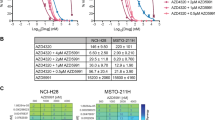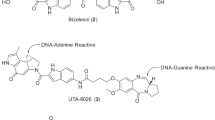Abstract
DBA2 mice were inoculated i.p. with 10(5)L1210 cells. Animals subsequently treated with daunomycin (single i.p. dose, 0.25-5.0 mg kg-1) all died. The maximum increase in mean survival time observed was approximately 135%. Animals treated with N-(2-hydroxypropyl)methacrylamide (HPMA) copolymers conjugated to daunomycin (DNM) showed a significant increase in mean survival time when the polymer-drug linkage was biodegradable (i.e., Gly-Phe-Leu-Gly). Such treatment also produced a number of long term survivors (greater than 50 days). In contrast, HPMA copolymer conjugated to DNM via a non-degradable linkage (Gly-Gly) produced no increase in survival time relative to untreated control animals. The effect observed with biodegradable HPMA copolymer-DNM conjugates was dependent on the concentration of conjugated drug administered (optimum greater than 5 mg kg-1); the frequency of administration (multiple doses were more effective than single); the timing of administration (single doses given on days 1 and 3 were most effective); and the site of tumour inoculation and route of drug administration. Biodegradable HPMA copolymer-DNM conjugates administered i.p. were active against L1210 inoculated s.c. at higher doses than required to curb a peritoneal tumour. Under certain experimental conditions polymer-DNM conjugates containing fucosylamine or galactosamine proved more active than conjugates without the carbohydrate moeity. The mechanism of drug-conjugate action in vivo is at present unclear. Radioiodination of polymer showed approximately 75% of polymer-drug conjugate to be excreted 24 h after i.p. administration. Synthesis of HPMA conjugates containing [3H]DNM showed that polymer containing Gly-Gly-[3H]DNM was excreted (60% of radioactivity in the urine, 24 h) in macromolecular form. In contrast polymer containing Gly-Phe-Leu-Gly-[3H]DNM was largely excreted in the form of low molecular weight species.
This is a preview of subscription content, access via your institution
Access options
Subscribe to this journal
Receive 24 print issues and online access
$259.00 per year
only $10.79 per issue
Buy this article
- Purchase on Springer Link
- Instant access to full article PDF
Prices may be subject to local taxes which are calculated during checkout
Similar content being viewed by others
Author information
Authors and Affiliations
Rights and permissions
About this article
Cite this article
Duncan, R., Kopečková, P., Strohalm, J. et al. Anticancer agents coupled to N-(2-hydroxypropyl)methacrylamide copolymers. II. Evaluation of daunomycin conjugates in vivo against L1210 leukaemia. Br J Cancer 57, 147–156 (1988). https://doi.org/10.1038/bjc.1988.31
Issue Date:
DOI: https://doi.org/10.1038/bjc.1988.31
This article is cited by
-
Antibody-targeted polymer-bound drugs
Folia Microbiologica (1995)



